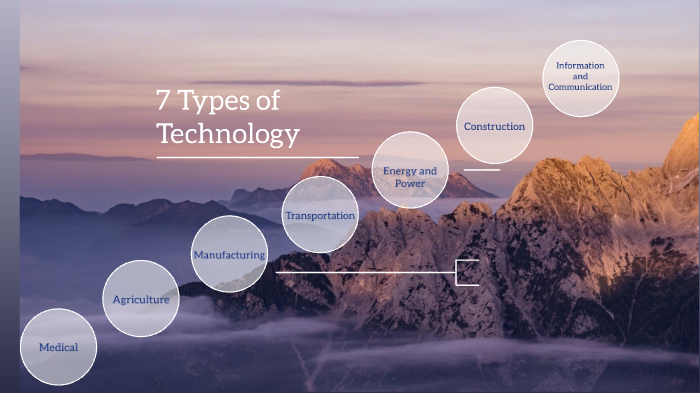What Are The 7 Types of Technology?

Unveiling the Future: The 7 Types of Technology Shaping Our World
In an era where innovation is the heartbeat of progress, technology continues to reshape every aspect of our lives. From the devices we use daily to the complex systems that power industries, technology has become indispensable. Understanding the different types of technology is crucial for navigating this rapidly evolving landscape. Let's delve into the seven types of technology that are driving change and innovation across the globe.
1. Communication Technology
Communication technology forms the backbone of our interconnected world. This includes everything from smartphones and computers to advanced systems like satellite communication and the internet. The recent advancements in 5G technology have revolutionized connectivity, enabling faster data transmission and supporting the growing demand for high-speed internet. With the advent of 5G, industries are experiencing a paradigm shift. Autonomous vehicles, smart cities, and the Internet of Things (IoT) are becoming more feasible, thanks to the low latency and high bandwidth provided by 5G networks. As we move towards 6G technology, the potential for even more sophisticated communication systems is on the horizon, promising to further integrate various aspects of our lives.2. Information Technology
Information technology, often abbreviated as IT, encompasses the development, management, and use of computer systems and software for storing, retrieving, and transmitting data. This field includes hardware, software, databases, networks, and more. The IT sector is essential for businesses, governments, and individuals, providing tools and infrastructure for data management and analysis. Companies are increasingly adopting cloud computing solutions, which offer scalability, flexibility, and cost-effectiveness. Artificial Intelligence and Machine Learning are also playing a significant role in IT, enabling predictive analytics, automation, and personalized services. The integration of AI in IT has led to the development of smart applications that can learn and adapt, enhancing user experiences and operational efficiency.3. Consumer Electronics
Consumer electronics refer to devices designed for everyday use, such as smartphones, tablets, laptops, and wearable technology. The consumer electronics market is highly competitive, with companies constantly innovating to meet the demands of tech-savvy consumers. Recent trends in consumer electronics include the rise of foldable smartphones, virtual reality (VR) headsets, and smart home devices. Companies like VVV and BTC are at the forefront of this innovation, leveraging advancements in materials science and software development to create cutting-edge products. The integration of AI and IoT in consumer electronics is also transforming the way we interact with our devices, making them more intuitive and responsive to user needs.4. Biotechnology
Biotechnology involves the use of biological systems or living organisms to develop or make products. This field includes genetic engineering, biopharmaceuticals, medical devices, and agricultural biotechnology. Biotechnology has significantly impacted healthcare, agriculture, and environmental sustainability. Recent breakthroughs in biotechnology include the development of CRISPR-Cas9 gene-editing technology, which allows scientists to precisely edit genomes. This technology has the potential to revolutionize the treatment of genetic disorders and diseases. In agriculture, biotechnology is used to create genetically modified crops that are more resistant to pests and diseases, improving food security.5. Construction Technology
Construction technology involves the use of innovative tools, equipment, and processes to improve the efficiency and sustainability of construction projects. This includes Building Information Modeling (BIM), 3D printing, and automated construction machinery. The construction industry is increasingly adopting these technologies to reduce costs, enhance safety, and minimize environmental impact. Automated construction machinery, such as drones and robotics, is being used for site inspections and material handling, reducing the need for human labor and improving accuracy. BIM allows architects and engineers to create detailed 3D models of buildings, facilitating better planning and coordination.6. Transportation Technology
Transportation technology encompasses the development and use of vehicles and systems for moving people and goods. This includes electric vehicles, self-driving cars, high-speed trains, and advanced aerospace technology. The transportation sector is undergoing a significant transformation with the adoption of green technologies and automation. Electric vehicles (EVs) are gaining popularity due to their environmental benefits and cost-effectiveness. Companies like Tesla are leading the charge in EV innovation, developing batteries with longer range and faster charging times. Autonomous vehicles, powered by AI and sensors, are also making strides, promising to reduce accidents and improve traffic flow. Aerospace technology is equally dynamic, with advancements in unmanned aerial vehicles (UAVs), space exploration, and hypersonic flight. The development of reusable rockets by companies like SpaceX is revolutionizing the space industry, making space travel more accessible and affordable.7. Energy Technology
Energy technology focuses on the generation, distribution, and use of energy. This includes renewable energy sources like solar, wind, and hydropower, as well as advanced fossil fuel technologies and energy storage solutions. The global shift towards sustainable energy is driven by the need to mitigate climate change and reduce dependency on finite resources. Solar and wind energy have seen significant advancements, with improvements in photovoltaic cells and wind turbine efficiency. Energy storage solutions, such as lithium-ion batteries and pumped hydro storage, are crucial for ensuring a reliable energy supply. Additionally, smart grids and microgrids are being developed to optimize energy distribution and improve resilience.As these seven types of technology continue to evolve, they will undoubtedly shape the future in profound ways. From enhancing communication and information exchange to revolutionizing healthcare and transportation, technology is the driving force behind progress. Staying informed and adaptable in this rapidly changing landscape is essential for individuals and organizations alike.
```
0 Response to " What Are The 7 Types of Technology?"
Post a Comment